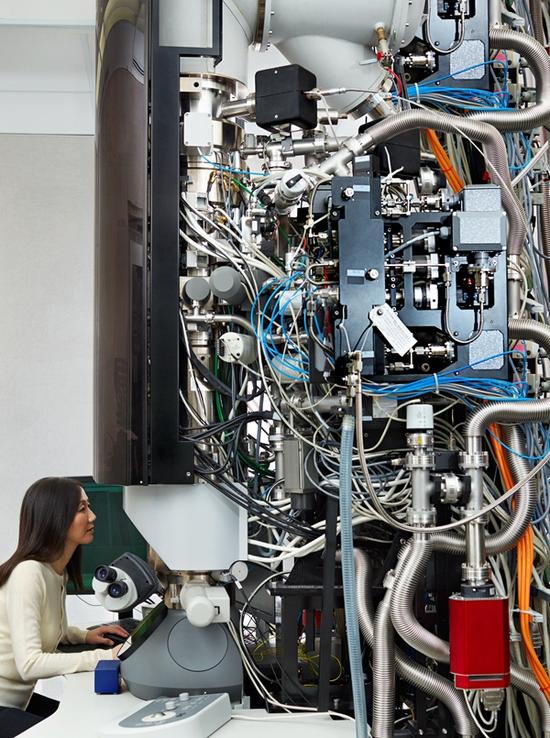
Pozennan in the laboratory
Bao Zhe Nan holding a transparent film material in her hand, at first glance, is like a hot-stamped plastic wrap in the shopping channel. This is a kind of polymer material born in the chemical engineering laboratory of Stanford University in the United States, which has excellent conductivity and stretchability. Baozhenan calls it "flexible electrode" in professional scientific terms. In the future, as an artificial skin material, on the one hand, it has a high degree of flexibility, stretching, and, like human skin, it can repair itself, but also can be biodegradable. More importantly, this kind of material is "conscious". It has a sense of touch and can not only feel sting but also sense the temperature in the surroundings.
Thirteen years ago, Bao Zernan, who worked at Bell Labs, gave up the temptation of greater salaries and better treatment. He headed into the department of chemical engineering at Stanford University and woven a dream for “artificial skin†with a group of students. In the latest issue of the "Scientific Progress" magazine, a research team led by Baozhan Nan published a report on related research results.
Artificial skin that appears only in science fiction movies may soon become a reality. As the main inventor, Baozhe Nan went from behind the scenes to the front desk. After being named the top ten scientific figures of the year by the authoritative scientific journal Nature magazine in 2015, Bao Zhe Nan won the 19th L'Oréal-UNESCO “World Outstanding Women Scientist Achievement Award†in March this year. Standing in front of a group of outstanding female scientists, Baozhannan appears to be delicate and petite, but her invention is recognized by the industry as likely to subvert the current development of the electronics industry.

The 19th L'Oreal-UNESCO "World Outstanding Women Scientist Achievement Award" awarded to five outstanding women scientists
In an interview with China Business News, Baozhenan said: “Our next step is to verify whether this material can implant into biological organisms and whether it will cause damage and injury to the body.†In the leading scientific field dominated by men Bao Zhenan like her invented flexible electrode, releasing tremendous flexibility.
Start with solving practical problems
According to Baozhenan, there are three challenges to develop flexible electrodes and use them in artificial skin research and development. “Our current electronic devices are made of hard materials. When measuring central nervous currents or cardiac currents, electrodes implanted in the brain or heart may damage nerves or heart tissue. The electrodes that come into contact with nerves must be as soft as skin, but This material did not exist before. So, one of the things we do is to make this kind of flexible material." According to the "Scientific Progress" report, Baozhan Nan team once selected a biocompatible and strong Conductive plastic. Bao Zhenan explained: "The reason why this material was selected was to ensure the safety of the electrode when it came into contact with the human body." However, the plastic is fragile and easily breaks. It is totally unsuitable as a carrier for wearable electronic devices.
In order to enhance the toughness and load-bearing capacity of this plastic, Baozhan Nan and her team tried to use a soap-like surfactant-like molecule as an additive to modify the material, completely changing the interaction between plastic molecules. "The small granular morphology formed by the molecules has become a fishing net shape under the action of additives. The fishnet morphology has a high structural stability, so that the original fragile polymer material becomes tough, and Easily stretched.†After testing, the improved new material stretched to twice its original length, still maintaining good conductivity.
The second hurdle is to let the material have human touch and perception. “In order to solve the tactile problem, we have specially designed a pyramid-shaped sensor that is 100 times thinner than human hair. Attached to flexible materials, they are still very sensitive.†On the issue, Baozhannan team has found some electronic circuit materials that will change once temperature or environmental factors change.
“The last challenge is to let the sensor and the electrical signal information be transmitted to the brain through the nerve center in time, and the brain must also understand what these electrical signals mean.†According to Bauzenan’s explanation, this determines that the electrical signal must be transmitted with certainty. The way and certain shape "contact" with the brain. "So we have to design electronic circuits so that they eventually become signals that the brain can understand." Flexible electrodes have entered the animal brain perception verification phase.
Although it takes some time for the flexible electrode material to be used by humans for electronic skin, it has begun to exert practical value. For example, Bao Zhe from South Korea, the touch sensor in the flexible electrode can be used to test the beat of the pulse and turn it into blood pressure information. The temperature sensor can be used as a high-temperature protection device for charging the lithium battery. Once overheating and superheat occur, the temperature sensor will automatically detect and cut off the power in a timely manner. The self-repair function of this material can even make the lithium battery of the electric vehicle even more powerful. stable.
Flexible electrodes are the result of many years of cultivation in the field of chemical engineering by Bauzenan. Following the Chinese-American polymer chemist Yu Luping, Bao Zhenan came into contact with the cutting-edge research in the field of interdisciplinary research. “This kind of feeling is like a door of novel science that opens slowly in front of you.†At this time, Baozhannan already had another layer of understanding of chemistry. “When you go deeper into the scientific world, you will find that it is necessary to understand these formulas and understand the data. When I realized this, the data and formulas were no longer dull and abstract in my eyes. Because they are one of the ways to solve specific problems."
The Dream of Runaway Heroes
Bao Zhenan’s scientific research road went smoothly. After graduating from PhD, he went directly to Bell Laboratories and worked with physicists and electronics engineers. Interdisciplinary scientists keep on wiping out sparks. "We didn't expect her to achieve such a big achievement at that time." In an interview with the media, Bao Zheernan's mother said that her daughter always exceeded their expectations. "After immigrating to the United States, my friends around me asked me," Why do you give the child so much pressure that forces her to go straight ahead? Actually, how can we put pressure on her? Those pressures are brought to her by herself. of. "In the area of ​​chemical engineering, Bao Zhenan is a gold medal signboard. Many research funds and funds are directed at her research. Baozhan Nan’s partner gave a very high evaluation of her ability. Several science and technology companies’ research funds have invested millions of dollars in Bao Zhe’nan’s R&D projects.
Bao Zhe Nan also had setbacks. She has collaborated with German scientists Schon et al. in the area of ​​popular superconductor, molecular electronics and molecular crystal scientific research. In 2002, Schon published papers in authoritative magazines such as "Nature" and "Science," announcing that they had produced the world's smallest nano-transistor. This achievement was once considered to have the power to sprint Nobel Prize. However, the credibility of the paper has triggered many criticisms in the field of scientific research. The conjecture and rumors of Baozhenan have followed. Shortly afterwards, the Review Committee appointed a team of experts to carry out a comprehensive investigation of the Schon’s research project. Eventually, the review committee quantified the matter in the conclusion report: “Shoon is indeed a fraud, while the other 20 scientists involved in the study are There is no connection between the Schoning fraud case and other researchers, including Bao Zhe Nan, who are unaware of it and have no responsibility or negligence. They have all been proven innocent.â€
"I never think of myself as a genius or talented person. What I can do is perseverance and optimism." Bao Zhe Nan said frankly that scientific research often requires scientific thinking and a "stupid approach." At this point, the father who was a professor at the Department of Physics at Nanjing University had a great influence on her. “When I was little, my father suddenly asked me when he was walking. When the ice fell on the water, it would float or sink. I took it for granted, because it was solid and it sank. My father encouraged me to do a little experiment to verify my own. Thought, as a result, I saw ice floating on the water. It was clear that the original ice had a lower density than water."
Once ignorant teenage girls have become female scientists who have changed the world and the future of humanity. Bao Zhe Nan wants to change not only the future, but also the moment. Baozhan Nan insisted on walking for an hour and one day to work. This is rarely seen in the United States where cars are used. She was therefore named Stanford University's "hero hero" and her portrait was printed on a poster. “I walked back and forth for an hour and I was able to exercise and listen to news and make phone calls. I like this lifestyle so much, so I encourage people around me to do the same.â€
Hdmi Switcher,Hdmi Switch,Switch Splitter,Smart Hdmi Switch
Dongguan Tuojun Electronic Technology Co., Ltd , https://www.fibercablessupplier.com
